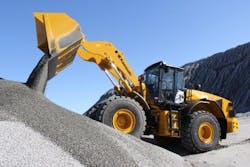Kawasaki Overhauls Wheel Loader Line
Kawasaki has introduced the first two models in its redesigned Z7 Series wheel loaders: the 85Z7 and 90Z7. This is Kawasaki’s first series upgrade since 2006, and it centers on the integration of Tier 4-Interim engines. Kawasaki, as have other manufacturers, implemented substantial design changes that touched everything except the tires, according to Gary Bell, VP and general manager of Kawasaki Construction Machinery Corp. of America (KCMA), which assembles and markets the machines in North America.
Tier 4-Interim diesels sparked the redesigns, and KCMA will use Cummins, Hino and Isuzu engines in the 7-model lineup. 85Z7 uses a 221-horsepower Isuzu diesel; the 90Z7 a 280-horsepoer Hino powerplant.
Many optional features from the 2006 series have been made standard, says Bell, because they are “performance- and convenience-related.”
“Making optional equipment standard cuts [manufacturing] costs and adds value,” he says. KCMA will absorb much of the research and development costs incurred to redesign the loaders for the new engines and mostly offset cost increases with the additional standard equipment.
Kawasaki will market Z7 Series features around four ‘benefit classes,’ defined as Efficient, Productive, Intelligent, Comfortable (EPIC).
The loaders use hydraulic piston pumps for fuel-efficiency, instead of gear pumps. Automode transmission allows the operator to select the shift mode that best fits the application. Kawasaki has doubled engine and hydraulic service hours to 500 hours and 4,000 hours, respectively. An HN bushing increase lube intervals to 500 hours. Lubricant in the bushing is replenished every time the pin is greased, then lubricant slowly escapes to extend the interval.
Excavator-style open center/load sensing hydraulics provide better feel and are more responsive than closed center systems, Bell says.
The loader line incorporates intelligent systems that adjust to working conditions in order to improve overall efficiency and production. Included is a patented Intellidig feature that balances rimpull and breakforce with digging into material such as shot rock. Simul-Load provides simultaneous control for tilt and raise during loading, then switches to tilt priority for the dump cycle.
Sounds levels have been reduced to a range of 72 to 74 dB(A) in the cab and 106 dB(A) outside. To help adjust for the larger engine compartment needed to accommodate the additional emissions hardware, Kawasaki tapered the hood on the sides to improve visibility. A rear camera is now standard, too, and provides excellent visibility in the blind spot directly behind the machine.
Four more models will be available by the end of the year. Bell says more than 80 dealers now represent Kawasaki in North America.
